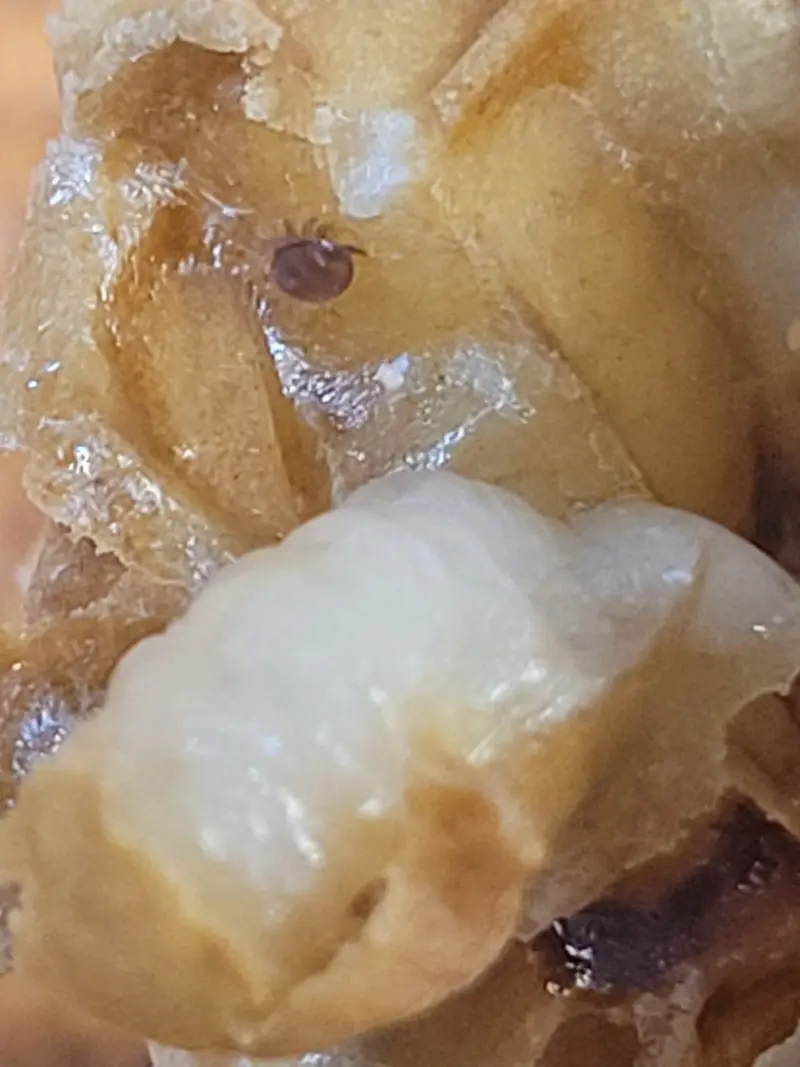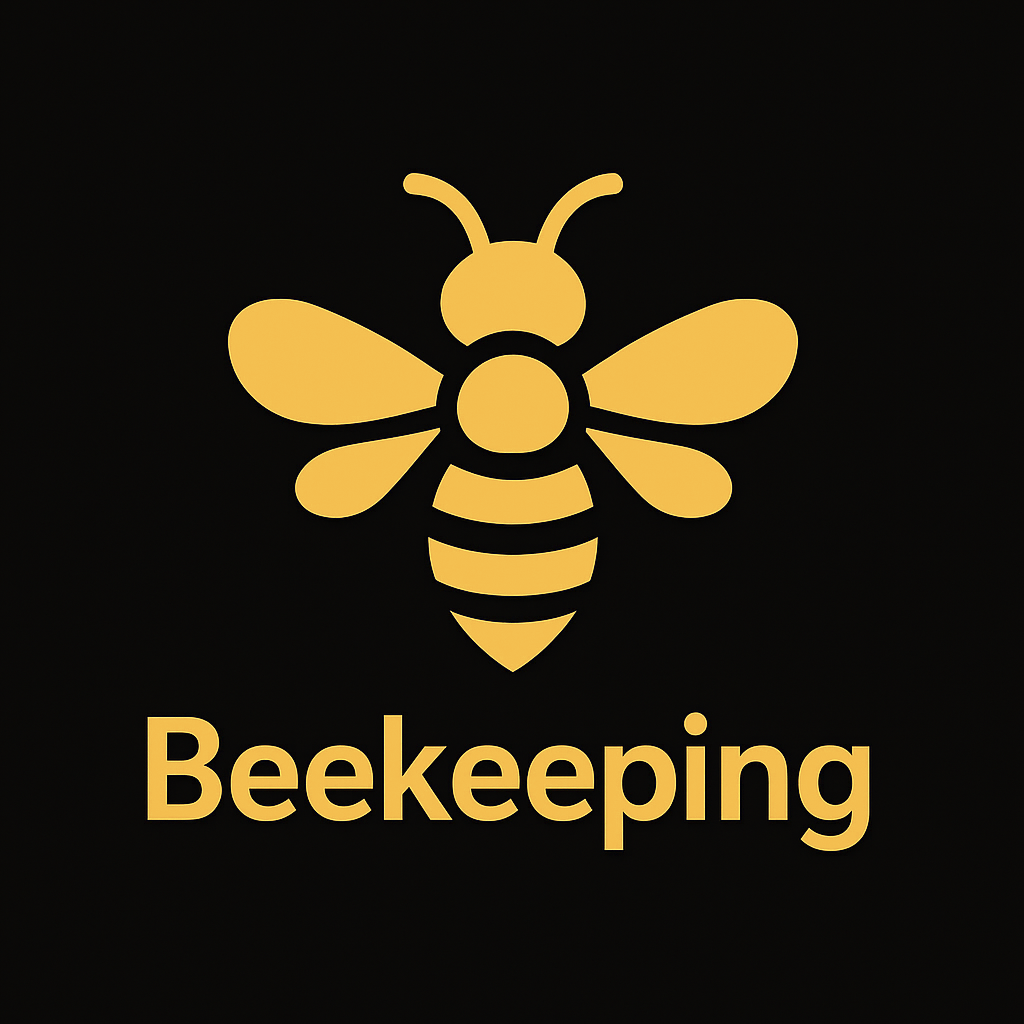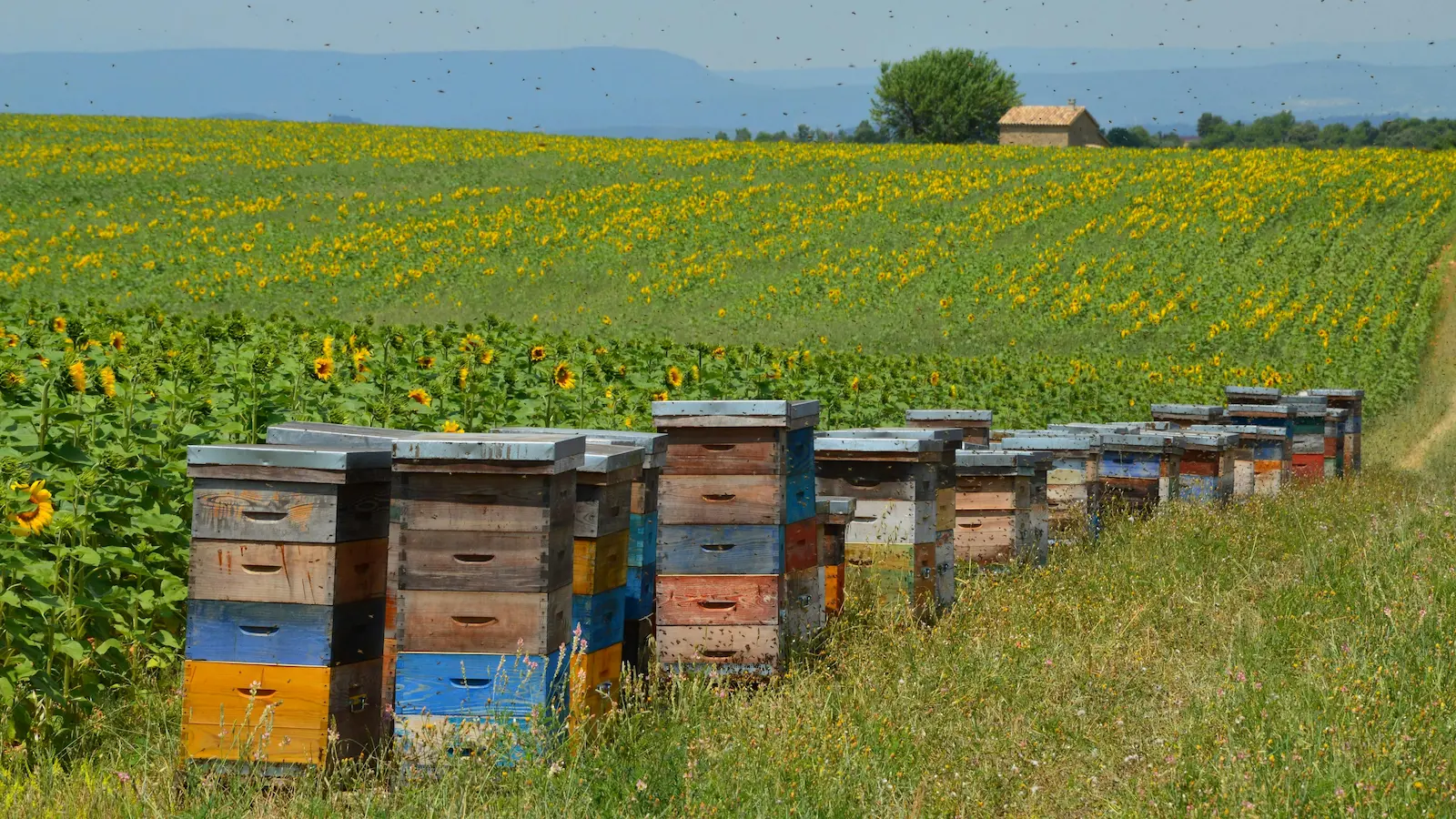Varroa Mite Management in the UK – Practical Overview

Varroa destructor is one of the most important health challenges facing honey bees in the UK. Learning how to treat varroa mites, when to monitor and how to plan seasonal control is now a standard part of responsible beekeeping. This page brings together the key concepts in one place so you can link them to your hive management and record-keeping.
What Is Varroa Mite?
Varroa destructor is a parasitic mite that feeds on honey bees and their developing brood. It originally evolved on Asian honey bees and has now spread widely in Apis mellifera colonies, including throughout the UK. Untreated, varroa and the viruses associated with it can kill colonies.
Varroa mites are reddish-brown, oval and about the size of a pin head. They use bees as transport and as a food source. Mites reproduce inside sealed brood cells, where they feed on developing pupae and emerge with the newly hatched bees to continue their life cycle.
Because varroa is present in most UK apiaries, the question is not “do I have varroa?”, but “how many mites do I have and what am I doing about them?”.
Understanding the Varroa Life Cycle (and Why Timing Matters)
Managing varroa mites in the UK is much easier when you understand how the mite lives and reproduces. Varroa has two main phases: a travelling phase on adult bees, and a breeding phase hidden inside capped brood. This is why timing matters so much — a large proportion of mites can be “protected” inside sealed cells at certain times of year.
Phoretic phase (on adult bees)
In the phoretic phase, varroa mites hitch a ride on adult bees. They feed primarily on the bee’s fat bodies, weakening bees and increasing the impact of viruses. During this phase mites can move around the colony and spread between colonies through drifting bees, robbing, swarming, and the movement of bees or equipment.
Reproductive phase (inside capped brood)
Varroa populations grow fastest when mites are reproducing. A mature female mite enters a brood cell shortly before it is capped. Once the cell is sealed, she lays eggs and the offspring develop alongside the developing bee. When the adult bee emerges, the mother mite (and often mature daughters) leave the cell and return to adult bees, ready to repeat the cycle.
Why mites prefer drone brood
Varroa mites often prefer drone brood because drones take longer to develop than workers. The extra time under the capping gives mites more opportunity to produce mature offspring before the bee emerges. This helps explain why drone brood removal (sometimes called drone brood trapping) can reduce mite reproduction as part of an integrated pest management (IPM) approach.
| Stage | Where the mite is | What’s happening | Why it matters for management |
|---|---|---|---|
| Phoretic (travelling) | On adult bees | Mites feed and move around the colony, transferring between bees. | Some monitoring reflects this phase. It also explains why mites can spread between colonies through drift, robbing and swarms. |
| Cell entry | At brood cells | A mature female enters a larval cell shortly before capping. | Once capped, mites become harder to reach. High brood levels can “hide” a large proportion of the mite population. |
| Reproductive (breeding) | Inside capped brood | Eggs are laid and offspring develop while the bee develops. | This is where mite numbers rise quickly. Brood breaks and biotechnical methods reduce breeding opportunities. |
| Emergence | Back on adult bees | Mother mite (and often mature daughters) leave with the emerging bee. | Populations can climb fast during periods of heavy brood rearing — especially late summer when winter bees are being raised. |
| Drone brood advantage | Drone cells (capped longer) | Drones take longer to develop than workers. | Longer capped time supports mite reproduction — explaining why drone brood removal can help as part of IPM. |
How Varroa Spreads Between Colonies
Varroa mites move around both within an apiary and across the wider landscape. Understanding the main routes helps you make sense of why mite levels can change quickly.
- Drifting bees: bees that accidentally enter nearby hives can carry mites with them.
- Robbing: when stronger colonies rob from weaker ones, mites can transfer along with the honey.
- Swarming and absconding: swarms and moved colonies take mites to new locations.
- Movement of equipment: moving combs, brood or bees between colonies spreads varroa along with disease.
Good practice in hive hygiene and careful movement of frames and equipment help slow this spread, even though it cannot be stopped completely.
Signs and Symptoms of Varroa
Some signs of varroa are easy to recognise once you know what to look for. Others are more subtle and overlap with other bee health issues. Regular inspections and a good understanding of “normal” brood and adult bees are essential.
- Mites on bees: reddish-brown mites visible on the thorax or between abdominal segments of adult bees.
- Deformed wings: bees with shrivelled or missing wings, often linked with viruses associated with varroa.
- Patchy brood pattern: brood areas with many empty cells, mis-shaped or sunken cappings.
- Weak or dwindling colonies: fewer bees on combs, reduced foraging and poor build-up.
- Increased virus problems: signs of paralysis, trembling bees or other virus symptoms may point towards high mite loads.
These signs also appear in other disease situations, so they should be interpreted alongside your varroa monitoring results and other health checks. The diseases and pests overview on this site links to more information on viral and bacterial diseases.
Monitoring Varroa – How to Measure Mite Levels
Monitoring tells you how serious your varroa problem is and whether your treatments are working. Relying only on guesswork or on how a colony “looks” can easily lead to under-treatment or missed problems.
Common monitoring methods used in the UK include:
| Method | What it measures | Advantages | Considerations |
|---|---|---|---|
| Sugar roll (icing sugar shake) | Approximate percentage of mites on adult bees | Non-lethal to bees, reasonably accurate | Requires collecting a sample and shaking; bees get dusted |
| Alcohol wash | Percentage of mites on adult bees | Very good estimate of infestation level | Bee sample is sacrificed, so not suitable for all situations |
| Sticky board / drop count | Mites dropping naturally or after treatment | Non-invasive, can show treatment effect | Can vary with colony behaviour and brood pattern |
| Drone brood uncapping | Mites reproducing in drone brood cells | Helpful for spotting heavy infestations in brood | Destroys some brood, interpretation needs practice |
| Visual checks only | Obvious mites and symptoms | Quick to do during inspections | Can miss serious infestations; not enough on its own |
In practice, many beekeepers choose one or two methods that fit their apiary and use them consistently, rather than changing methods every time.
Sugar Roll
A measured sample of bees is collected into a jar with icing sugar, rolled gently and then shaken so mites fall through a mesh lid. Counting mites and bees gives an estimate of infestation level.
Alcohol Wash
Bees are collected into a jar containing alcohol or another suitable fluid, then gently agitated so mites detach. This gives a good estimate, but the sample cannot be returned to the hive.
Sticky Boards
A removable board beneath an open mesh floor catches fallen mites. Using it for several days gives an average daily mite drop, often before and after treatment.
Varroa Thresholds and Seasonal Planning in the UK
Varroa thresholds are guideline mite levels at which treatment is recommended. Exact numbers vary with local guidance and the time of year, but the principle is the same: monitor, compare with a threshold, then decide on action.
The table below gives an illustrative example of how thresholds can be thought about across the season. It is not a substitute for official advice:
| Time of year | What you are watching for | Example response |
|---|---|---|
| Spring build-up | Rising mite levels as brood increases | Monitor and note trends. Plan ahead for late summer treatment if levels climb. |
| Summer / honey flow | Signs of heavy infestation, virus problems | Avoid disrupting honey crop with unsuitable treatments. Keep monitoring and prepare for prompt action after supers are removed. |
| Late summer / early autumn | Varroa levels affecting the bees that will carry the colony through winter | Often a key treatment window in the UK. Choose appropriate treatment based on monitoring and guidance. |
| Mid-winter (little or no brood) | Residual mites on adult bees | Some beekeepers use a suitable winter treatment when little or no brood is present, following product instructions. |
Varroa planning should link with your monthly apiary tasks and other aspects of colony management such as feeding, queen performance and comb renewal.
Integrated Pest Management (IPM) for Varroa Mites
Integrated Pest Management (IPM) means using a range of methods together rather than relying on a single product. For varroa, this typically includes:
- Regular monitoring using one or more methods.
- Good hive hygiene, including comb renewal and sensible movement of frames.
- Seasonal planning so treatments are timed when they are most effective.
- Use of appropriate, approved treatments when thresholds are reached.
- Non-chemical methods, such as drone brood removal or brood breaks, where suitable.
IPM is not about avoiding treatments altogether, but about making smarter, better timed decisions so colonies stay healthy and treatments remain effective for longer.
Chemical and Non-chemical Varroa Treatment Options
- Use only approved products for varroa control in your country.
- Read and follow the product label and safety information carefully.
- Observe withdrawal periods for honey and other products.
- Check current UK guidance and, if in doubt, ask your bee inspector or association.
If you want a simple, printable summary to keep in the shed or take to the apiary, these free downloads explain your options and the safety considerations in plain English.
-
Chemical varroa treatments (overview):
when different treatment types are typically used in the UK season, what conditions matter (especially temperature),
and why rotating treatment types helps reduce the risk of resistance.
Download: Chemical varroa treatments (PDF) -
Non-chemical varroa control (IPM methods):
practical biotechnical options like drone brood removal, brood breaks and other ways to reduce mite pressure
without relying on medicines alone.
Download: Non-chemical varroa control (PDF) -
PPE for varroa treatments:
what personal protective equipment is commonly recommended, why it matters, and the key safety principles to follow
before and after treatment.
Download: PPE for varroa treatments (PDF)
Reminder: these downloads support good practice but do not replace product labels or current UK guidance.
Chemical Treatments – Overview
UK beekeepers have access to several categories of approved varroa treatments. Brand names and products change over time, but they generally fall into these groups:
- Organic acid-based treatments: such as oxalic acid or formic acid products, often used at specific temperatures and, in some cases, when little or no brood is present.
- Plant-derived (essential oil) treatments: such as thymol based products, often used in late summer or early autumn when honey supers have been removed.
- Synthetic treatments: such as certain pyrethroid based products, where resistance patterns and current guidance allow their use.
Each group has its own temperature requirements, timing considerations and guidance on honey supers. Product leaflets provide the detailed instructions you must follow.
Non-chemical Measures
Non-chemical methods rarely replace treatments completely, but they can reduce mite pressure and support overall colony health:
- Drone brood removal: encouraging drone brood on specific frames then removing and destroying it before emergence.
- Brood break strategies: temporary interruption of brood rearing, for example through queen caging or controlled splits, to expose more mites to treatment or natural drop.
- Colony selection: favouring queens from colonies that cope well with varroa and show good hygiene behaviour.
Example Varroa Treatment Comparison
The table below is a simplified comparison of how different approaches might fit into a seasonal plan. It is not a list of products and does not replace product instructions or official guidance.
| Approach | Typical timing | Works best when | Notes |
|---|---|---|---|
| Organic acid treatment during broodless period | Mid-winter or artificial brood break | Little or no sealed brood present | Often used to reduce mite levels on adult bees; follow temperature and safety guidance. |
| Thymol based late-summer treatment | After honey supers are removed | Within recommended temperature range | Common in UK as a post-harvest treatment; helps protect winter bees. |
| Drone brood removal | Spring and early summer | When colonies are producing excess drone brood | Helps reduce mite reproduction in drone cells; used alongside other methods. |
| Brood break combined with treatment | Planned as part of swarm control or requeening | When you can safely interrupt brood rearing | Can increase the impact of certain treatments by exposing more mites on adult bees. |
Local beekeeping associations and bee inspectors can help you choose a treatment plan that fits your area, your bees and your own beekeeping style.
Common Mistakes New Beekeepers Make with Varroa
Even experienced beekeepers occasionally slip up with varroa. Being aware of typical mistakes can help you avoid them.
- Relying on visual checks only: not using monitoring methods and assuming “no obvious mites” means “no problem”.
- Treating at random: using products without linking them to monitoring results or seasonal plans.
- Ignoring product instructions: guessing doses, timings or conditions instead of following the label.
- Reusing old comb indefinitely: never renewing comb, which can add to disease and pesticide residues.
- Moving infested frames between colonies: spreading mites and disease around the apiary.
Using Records and Tools Like HiveTag for Varroa Management
Varroa management works best when it is part of your overall hive record system. Notes on monitoring, treatment dates, products used and observed effects help you make better decisions next year.
Many varroa controls are classed as veterinary medicines. In the UK, keep a clear record of what you used, which hive was treated, the date(s), dose/quantity, and any withdrawal period or honey-handling notes. A practical rule is to retain these records for at least five years.
See: Veterinary Medicine Records for a simple checklist and a downloadable record template.
Some beekeepers like paper records in the apiary; others prefer digital tools. The HiveTag web app is designed to make it easy to record inspections, varroa checks and treatments on a phone or tablet, so you always know what was done and when.
Whatever method you use, the aim is the same: clear, simple records that help you keep bees healthy for the long term.
Frequently Asked Questions – Varroa Management
- Is it possible to keep bees in the UK without varroa?
In most areas, varroa is now well established. Completely varroa-free colonies are rare, so beekeepers generally focus on managing mite levels rather than trying to keep colonies completely free forever. - How often should I treat for varroa?
There is no single schedule that suits everyone. Many UK beekeepers plan treatments around late summer and mid-winter, based on monitoring results and current guidance. Over-treating or under-treating can both cause problems. - Can I skip treatment if my colony looks strong?
A colony can look strong while carrying a heavy mite load. Monitoring gives a clearer picture than appearance alone. Skipping treatment without monitoring risk can put bees under serious pressure. - Does varroa only affect weak colonies?
Strong colonies can also be badly affected by varroa, especially when mite levels rise late in the season. Healthy, well managed colonies may cope better, but they are not immune. - Will treating once solve the varroa problem?
Varroa management is ongoing. A single treatment might reduce mites, but without follow-up monitoring and future planning, levels can quickly climb again. - Do I need different varroa strategies for different apiaries?
Possibly. Differences in forage, local conditions, colony density and neighbouring beekeeping practices can all influence how quickly varroa spreads and how you plan control. - Can varroa mites develop resistance to treatments?
Yes, resistance to some treatment types has been recorded in various areas. Following guidance, rotating treatments sensibly and avoiding under-dosing helps slow resistance development. -
Does good nutrition help bees cope with varroa?
Strong colonies with good forage often cope better with stress, including varroa and associated viruses. Linking varroa management with good forage and adequate feeding is therefore important. - Should I ask for help if I am unsure?
Yes. Local beekeeping associations, mentors and bee inspectors are there to help. Bringing frames to a training session or asking for a visit can make varroa management feel much less daunting. -
Do I need to record varroa treatments, and how long should I keep the record?
Yes. Many varroa products are veterinary medicines, so keep a simple treatment log (product, date(s), hive ID, quantity/dose, batch number if shown, and any withdrawal period notes) and retain it for at least five years. See Veterinary Medicine Records. -
Where can I read more about bee diseases as a whole?
The Bee Diseases and Pests section of this site links to pages on bacterial diseases, viral problems, pests, mites and other conditions so you can build a complete picture of honey bee health.

